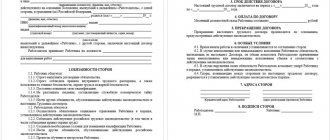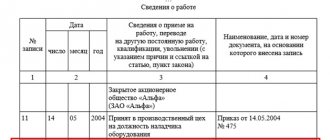Coordination of translation
An employee can be transferred to a permanent job in another organization by mutual decision of the current employer and the receiving organization. In this case, the initiator of the transfer can be either the employer or the employee. This is stated in Part 2 of Article 72.1 of the Labor Code of the Russian Federation.
This transfer occurs through dismissal from the previous place of work, since in another organization a new employment contract is concluded with the employee (part 4 of article 64 and part 2 of article 72.1 of the Labor Code of the Russian Federation).
The procedure for transfer through dismissal is not clearly stated in the Labor Code of the Russian Federation, but a certain practice has developed in its execution. The transfer must be preceded by a written agreement procedure between the head of the organization from which the employee is transferred and the head of the organization to which he is transferred.
Stage 6Issue to the employee a certificate of the amount of earnings
On the day of termination of the employment contract, the employer is obliged to issue the employee (insured person) a certificate of the amount of earnings for the two calendar years preceding the year of termination of work, the current calendar year for which insurance premiums were calculated (Clause 3, Part 2, Article 4.1 of the Federal Law dated December 29, 2006 No. 255-FZ “On compulsory social insurance in case of temporary disability and in connection with maternity”).
NA No. 5'2011 The form and procedure for issuing such a certificate are approved by order of the Ministry of Health and Social Development of Russia dated January 17, 2011 No. 4n “On approval of the form and procedure for issuing a certificate of the amount of wages, other payments and remunerations for which insurance contributions for compulsory social insurance were calculated in case of temporary disability and in connection with maternity, for two calendar years preceding the year of termination of work (service, other activities) or the year of applying for a certificate, and the current calendar year.”
Translation by decision of organizations
If the transfer of an employee is carried out by decision of the organizations (current and receiving), the hiring and dismissal procedure will be as follows. To begin with, the head of the organization where the employee is being transferred must send a letter of request to the organization where he currently works, requesting his transfer. The request must indicate the date from which the employee is expected to be hired for a new job and his new position. Having received a letter of request, the head of the organization where the employee works is obliged to agree with the subordinate on the possibility of transfer.
If the employee agrees, he writes a letter of resignation in connection with the transfer, to which is attached a letter of request. This statement will be proof that he has expressed his consent to the transfer in writing. Then the head of the organization where the employee works must send a confirmation letter to the other organization.
From this moment on, it is possible to dismiss an employee from his previous place of work and hire him for a new job.
A pregnant employee, with her written consent, can also be transferred to another organization. The legislation does not contain such a prohibition. Complete the translation in the usual manner.
Situation: is it possible to dismiss an entire department by transfer to another organization?
Yes, you can.
The Labor Code of the Russian Federation does not prohibit dismissing an entire department by way of transfer (Part 2 of Article 72.1 of the Labor Code of the Russian Federation). In this case, the desire of the new manager to hire several employees can be expressed in one letter of request addressed to the current manager. It can list all the citizens whom he is ready to employ.
Notification of transfer to another place of work sample
Some HR specialists do not want to compile any “unnecessary documents” and ask the employee to write on a copy of the transfer order that he agrees with future changes in his work. However, a person's attitude towards translation may soon change. In the first case, the employee can be called to notify about upcoming changes in writing or orally.
If an employee refuses to appear, it is advisable to send documents by mail. An employee has the right to refuse to express his attitude to the changes. In this case, an act is drawn up recording the refusal to read the notification. In addition, if an employee informs in advance that he is not interested in the employer’s offer and prefers to quit, the latter also gets some time to search for a replacement for the employee.
What does transfer mean? The transfer of an employee is always accompanied by changes in the staffing table and in the terms of the previously signed employment contract. Moreover, with regard to the contract, adjustments can occur not only in the title of the position, but also in the standard working hours, work schedule, wages, etc. The law allows for the transfer to a shortened, part-time or 0.5 rate of employees in the event , when changes in production organization or technology may lead to mass layoffs for up to six months. To a lower position. This type of transfer is also permitted with the consent of the employee.
To date, there is no unified notification standard, so companies can write it in free form or use a template developed within the enterprise and approved in its accounting policies. At the same time, there is a number of information that is recommended to be provided in the document: The importance of the notification is difficult to overestimate: given to the employee on time and in accordance with all the rules, it gives him the opportunity to decide on future plans and carefully weigh all the pros and cons. If he is not satisfied with the employer's offer, he gets enough time to look for another job.
An employee’s working conditions can only be changed with his written consent (oral agreements do not count), which is why at a certain stage, obtaining a positive response from a subordinate becomes the employer’s main task. A written notice of transfer serves precisely this purpose. In cases where consent to the transfer is received, all necessary changes are made to the employment contract and the employee’s personal documents (work book, personal file), an order is issued on behalf of the manager, and the employee can begin his new work responsibilities in a different position.
Transfer at the initiative of the employee
If an employee himself has asked to be transferred to work in another organization, then the first link in the chain of approval of the transfer will be the employee’s application. Then the head of the organization where the employee works must inform in writing about the subordinate’s desire to the head of the organization to which the employee wants to move and obtain his consent. Further, the dismissal and hiring procedures are carried out according to general rules.
Attention: it is impossible to refuse to conclude an employment contract for an employee invited to work as a transfer from another organization. This prohibition is valid for one month from the date of dismissal from the previous place of work. This procedure is specified in Article 64 of the Labor Code of the Russian Federation.
Thus, if the new manager refuses employment to the transferred employee, this will be a violation of labor laws. For this, the labor inspectorate may fine the organization or its officials.
The fine is:
- for officials of the organization (manager) – from 1000 to 5000 rubles. (repeated violation entails a fine of 10,000 to 20,000 rubles or disqualification for a period of one to three years);
- for entrepreneurs – from 1000 to 5000 rubles. (repeated violation entails a fine of 10,000 to 20,000 rubles);
- for an organization – from 30,000 to 50,000 rubles. (repeated violation entails a fine of 50,000 to 70,000 rubles).
Such measures of liability are provided for in parts 1 and 4 of Article 5.27 of the Code of the Russian Federation on Administrative Offenses.
In addition, such a refusal could lead to problems for the former manager. An employee who has received a refusal has the right not only to appeal this refusal in court, but also to demand reinstatement at his previous place of work (Article 394 of the Labor Code of the Russian Federation). In this case, the organization must pay the reinstated employee the time of forced absence in the amount of average earnings. This is stated in paragraph 60 of the resolution of the Plenum of the Supreme Court of the Russian Federation dated March 17, 2004 No. 2.
The court may also oblige the organization to compensate an illegally dismissed employee for moral damages. The amount of compensation for moral damage is determined by the court and indicated in its decision. In this case, judges must take into account the nature of the harm caused to the employee and the degree of guilt of the organization (clause 63 of the resolution of the Plenum of the Supreme Court of the Russian Federation of March 17, 2004 No. 2).
If the dismissal was declared illegal, the employee must be reinstated.
Notice of transfer to another location
LLC*** notifies you that due to a change in the staffing table from 12/28/15, approved by order dated 10/15/15, the position you occupy will be transferred along with the structural unit to the location of the Separate Division Saratov LLC** * at the address: Saratov region. , ****. Additionally, we notify you of the temporary suspension of work in your position (downtime due to the fault of the employer) in the period from 10/26/15 due to economic and organizational reasons based on the order dated 10/15/15. Payment for downtime will be made to you in accordance with the requirements of the legislation of the Russian Federation and local regulations of the employer. The date of return to work after the end of the downtime is November 26, 2015.
In accordance with Part 4 p. 74 of the Labor Code of the Russian Federation, if the employee refuses the proposed job, the employment contract is terminated in accordance with clause 7, part 1, art. 77 of the Labor Code of the Russian Federation (an employee’s refusal to continue working due to a change in the terms of the employment contract determined by the parties). In this case, the employment contract is subject to termination no earlier than two months from the date of delivery of this notice to you. Hello! I ask for help and advice regarding the following current situation: I and two of my colleagues are employees of the accounting department of LLC ***.
Legal and fact. address in Moscow. Jobs in Moscow, where we got a job. Our entire department (office) consists of the three of us and the head. accountant. Due to the employer’s dishonesty in terms of payment of wages and tax evasion, as a result of which complaints were received against him by the State Tax Inspectorate and inspections were carried out, management decided that the initiator of the inspections were the accounting department employees.
As a result, when we arrived at work on 10/26, we discovered that all working documentation, working PCs, etc. had been confiscated. office equipment was confiscated, i.e., we were actually deprived of the opportunity to perform our work. responsibilities. The management handed us Notices of transfer to another location with the following content: LLC*** offers you a transfer to work in another area at the above address without changing the other conditions of the employment contract previously concluded with you. The costs of your relocation to another location will be reimbursed by the employer accordingly. from Art. 169 Labor Code of the Russian Federation.
If you do not agree to continue working under the new conditions, you have the right to terminate the employment contract before the expiration of a two-month period from the date of delivery of this notice. In this case, as an additional guarantee from the employer, you will be paid monetary compensation in the amount of two weeks' average earnings.
Dismissal from a previous employer
When transferring an employee to work in another organization, the previous organization must:
- issue an order to terminate the employment contract in connection with the transfer using the unified form No. T-8 or an independently developed form (Part 4 of Article 9 of the Law of December 6, 2011 No. 402-FZ, letter of Rostrud of February 14, 2013 No. PG/1487-6-1);
- close the employee’s personal card;
- make an entry in the employee’s work book. “Dismissed by transfer to (name of organization) with the consent of the employee, paragraph 5 of part 1 of Article 77 of the Labor Code of the Russian Federation,” if the employee was transferred by decision of the organization. If the employee was transferred on his own initiative, you need to make an entry: “Dismissed by transfer to (name of organization) at his request, paragraph 5 of part 1 of Article 77 of the Labor Code of the Russian Federation.” This follows from part 5 of article 84.1 and part 2 of article 72.1 of the Labor Code of the Russian Federation, paragraph 6.1 of the Instructions approved by Resolution of the Ministry of Labor of Russia of October 10, 2003 No. 69, paragraph 15 of the Rules approved by Decree of the Government of the Russian Federation of April 16, 2003 No. 225.
How far in advance should an employee be notified of a transfer to another department?
According to the requirements of Article 74 of the Labor Code of the Russian Federation, the employee must be notified in writing about the proposed transfer at least two months in advance. If an agreement has been reached with the employee on the transfer, there is no need to postpone changing the terms of the employment contract for 2 months. According to the terms of Article 72 of the Labor Code of the Russian Federation, if the parties agree, changes to the employment contract regarding transfer to a new job come into force on the agreed date. If the employee does not agree with the new conditions, the company is first obliged to offer him another job that corresponds to his qualifications and taking into account his state of health.
Rules for drawing up a notification Today, there is no unified standard for notification, so companies can write it in free form or use a template developed within the enterprise and approved in its accounting policies. At the same time, there is a number of information that is recommended to be provided in the document: All updated information is entered into the employee’s personal card, but his personnel number remains the same (unless this concerns a transfer to another company - there the employee receives his own individual personnel number). Is it necessary to obtain the employee’s consent for a transfer? Changing the employee’s working conditions can only be done with his written consent (oral agreements do not count), which is why at a certain stage, obtaining a positive response from a subordinate becomes the main task of the employer.
A written notice of transfer serves precisely this purpose. Is the employee obligated to agree to the transfer? The employee has every right to both agree to the transfer and refuse it. Typically, refusals occur in cases where the change in working conditions is negative, for example, wages are significantly reduced or the work schedule becomes inconvenient. Filling out documents Copying site materials without permission is prohibited Notifying an employee about a transfer You can send a notification in different ways: by sending it via Russian Post by registered mail with return receipt requested, or by handing the message in person. Further, if an employee refuses to be transferred to a specific position (regardless of the reasons for this), the employer must offer him other available vacancies within the company, but if the employee refuses them too or there are no such vacancies at the enterprise, he may be fired. - for the purpose of replacing an absent employee - no more than one year.
Subscribe to our daily newsletter for the best articles! The procedure for transferring an employee to another job Most often, it is the employer who initiates personnel changes.
Reception by a new employer
If an employee is transferred to work from another organization, the receiving organization must:
- draw up an employment contract with a citizen (Article 67 of the Labor Code of the Russian Federation);
- issue an order for employment using a unified form No. T-1 (No. T-1a) or an independently developed form (Article 68 of the Labor Code of the Russian Federation, Part 4, Article 9 of the Law of December 6, 2011 No. 402-FZ, letter Rostruda dated February 14, 2013 No. PG/1487-6-1);
- create a personal card;
- make an entry about hiring in the employee’s work book: “Accepted to (name of structural unit) for position (name) in the order of transfer from (name of organization)” (clauses 3.1 and 6.1 of the Instructions approved by the resolution of the Ministry of Labor of Russia dated October 10, 2003 No. 69).
An example of a transfer to a permanent job in another organization
The head of the Alpha organization invited economist A.S. as a transfer from the Hermes organization. Kondratieva (request letter). The head of Hermes agreed, and the employee himself was not against it. Kondratyev wrote a letter of resignation, about which the head of Hermes sent a confirmation letter.
The head of Hermes issued a dismissal order in connection with the transfer in form No. T-8. A record of dismissal due to the transfer was entered into the work book.
The head of Alpha issued an order to hire Kondratiev. A record of employment in connection with the transfer was made in the work book.
Situation: is it possible to establish a probationary period when transferring an employee to a permanent job in another organization?
No you can not.
This is directly stated in Article 70 of the Labor Code of the Russian Federation. If you include this condition in the employment contract, it will not apply (Article 9 of the Labor Code of the Russian Federation).
Attention: if, when transferring an employee to a permanent job in another organization, a probationary period is established for him, labor laws will be violated.
For this violation, the labor inspectorate may fine the organization or its officials. The fine is:
- for officials of the organization (for example, a manager) - from 1000 to 5000 rubles. (repeated violation entails a fine of 10,000 to 20,000 rubles or disqualification for a period of one to three years);
- for an entrepreneur – a fine in the amount of 1,000 to 5,000 rubles. (repeated violation entails a fine of 10,000 to 20,000 rubles);
- for an organization – from 30,000 to 50,000 rubles. (repeated violation entails a fine of 50,000 to 70,000 rubles).
Such measures of liability are provided for in parts 1 and 4 of Article 5.27 of the Code of the Russian Federation on Administrative Offenses.
Stage 8 Registration of a personal file
Please note: this step is absent if the employee does not have a personal file.
In non-state commercial organizations, maintaining personal files of employees, in contrast to issuing personal cards for employees, is not mandatory. The issue of the need to register and maintain personal files is decided by each employer independently.
If a personal file is maintained for an employee, then after the termination of the employment contract with such an employee, his personal file is filed for storage.
Step 1: Organize the documents in the case
Documents in the employee’s personal file are placed as they are received and systematized in the following sequence:
- internal inventory of documents available in the personal file;
- questionnaire (personal sheet for personnel records);
- autobiography;
- copies of education documents;
- employment contract;
- personnel order on hiring an employee;
- copies of documents prepared during the employee’s work;
- additions to the questionnaire (personal sheet for personnel records), copies of the employee’s personal documents, etc.;
- order for personnel on termination (termination) of an employment contract with an employee (dismissal).
Please note: documents that have a temporary storage period cannot be organized in personal files: employee statements, orders for vacations and business trips, etc. These documents are removed from the personal file and included in the act of destruction.
Step 2 Hem or bind the case
Personal documents are enclosed in a hard cover or cardboard, hemmed or bound in four holes with strong threads. Documents are filed and bound so that the text of the document, dates, visas and resolutions on them can be easily read. Metal fastenings of documents (pins, paper clips) are confiscated.
At the beginning of the personal file, a blank sheet of paper is placed, at the end - a sheet - a witness of the case. After a blank sheet of paper, an internal inventory of the documents in the personal file is filed.
Step 3 Number the sheets in the case
All sheets of the personal file are numbered in expanded form with Arabic numerals in gross order. Sheet numbers are written in black pencil in the upper right corner of the sheet in a space free from text. The internal inventory sheets are numbered separately from the personal file documents.
Step 4 Compose a certification letter for the case
To take into account the number of sheets in the case and record the peculiarities of their numbering, a certification inscription of the case is drawn up. It is drawn up on a separate certification sheet in the prescribed form.
Step 5 Sign the certification sheet
The certification is signed by its originator, indicating the name of the position, the transcript of the signature and the date of preparation.
Step 6 We draw up an internal inventory of case documents
The internal inventory is compiled on a separate sheet and contains information about the serial numbers of the case documents, their indexes, dates, headings and numbers of the sheets of the case on which each document is located.
A final entry is made for the internal inventory, indicating in numbers and in words the number of included documents and the number of sheets of the internal inventory.
Step 7 Sign the internal list of case documents
The internal inventory is signed by its compiler, indicating the name of the position, the transcript of the signature and the date of compilation of the inventory.
Step 8: Design the cover of the case
The required elements of the cover of a personal file are:
1. Name of the organization;
2. Case index (according to the nomenclature of cases);
3. Case title, consisting of several elements: name of the type of case (personal file); summary of the case documents; dates (period) to which the case documents relate.









